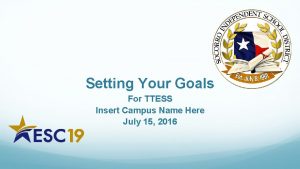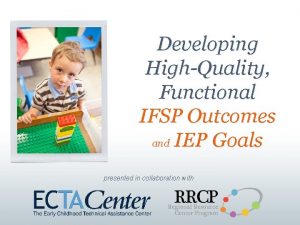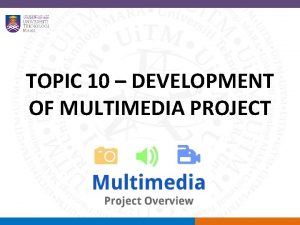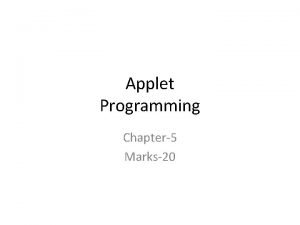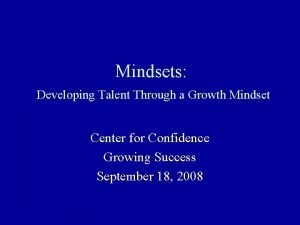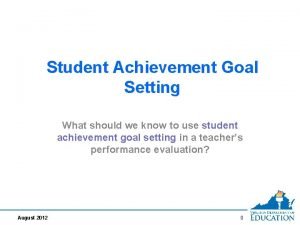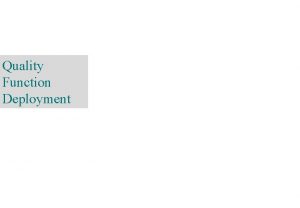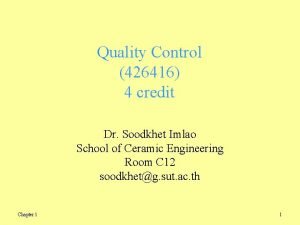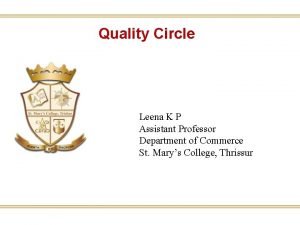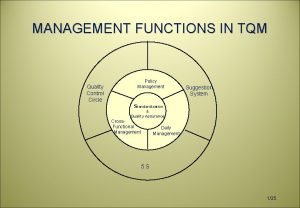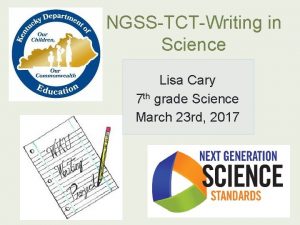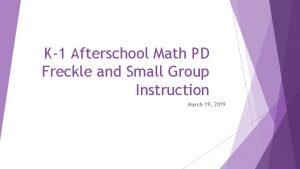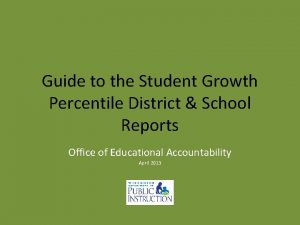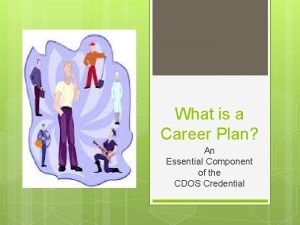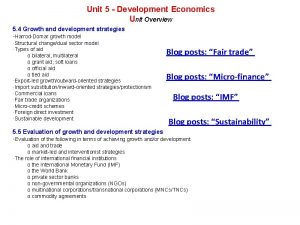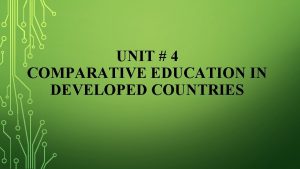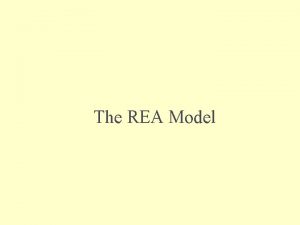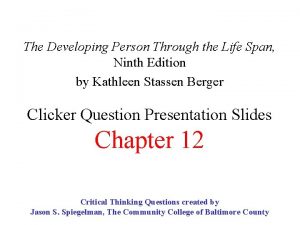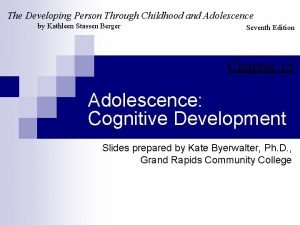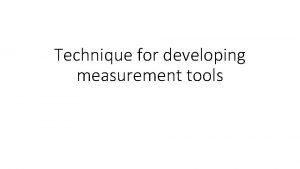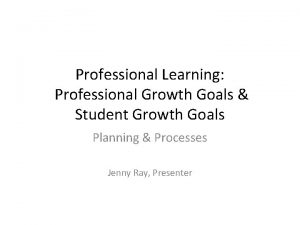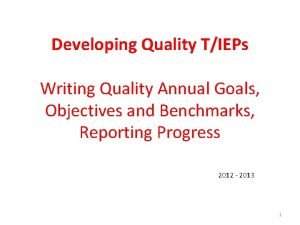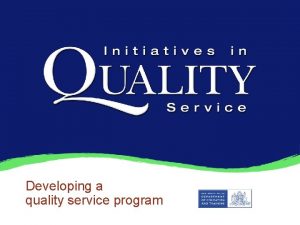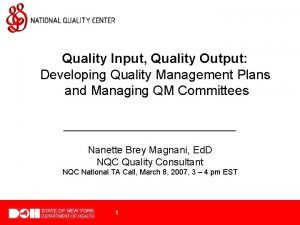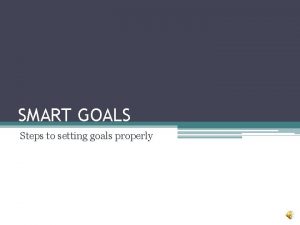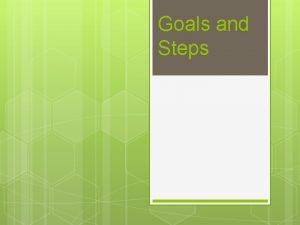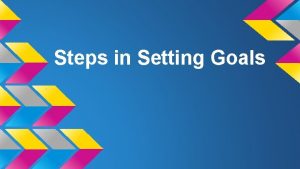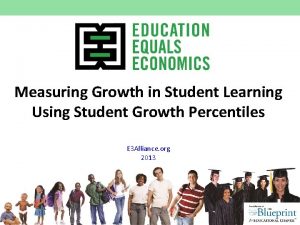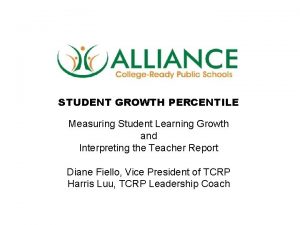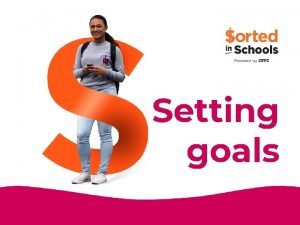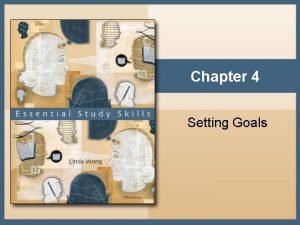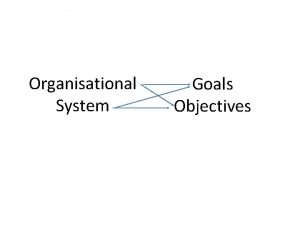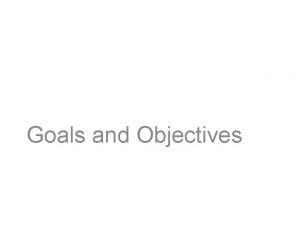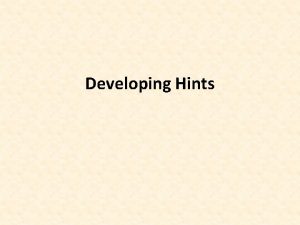Student Growth Developing Quality Growth Goals STEPS 3
























































- Slides: 56

Student Growth Developing Quality Growth Goals STEPS 3 -4 -5 Teacher Professional Growth & Effectiveness System (TPGES) 4

Domain 1: Planning & Preparation Domain 2: Classroom Environment Domain 3: Instruction Domain 4: Professional Responsibilities 2

PGES Sources of Evidence These provide multiple sources of evidence to inform professional practice State Contribution: Student Growth % Local Contribution: Student Growth Goals 3

Targets ü ü I can apply guiding questions to implement student growth goal-setting. I can determine effective teaching & learning strategies to support students’ goal attainment. I can implement strategies and monitor student progress toward goal attainment as a recursive process. I can determine goal attainment. 8

Student Growth Process 9

w e i v 1 Re SG m o r f Determine needs. Ø Identify the essential /enduring skills, concepts & processes for your content area for your content/grade-level standards. Ø Determine what mastery of those skills/learning, concepts & processes looks like. Ø Pinpoint critical areas of need. 6

Decide on sources of evidence. Do the sources of evidence provide the data needed to accurately measure where students are in mastering the identified skills, concepts, and/or process for the identified area(s) of need? 11

Decide on sources of evidence. Do the sources of evidence provide the data needed to accurately measure where students are in mastering the identified skills, concepts, and/or process for the identified area(s) of need? Review 1 from SG nd o y e b k n cil i n h e T p d n a r pape ests. t 8

Sources of evidence for student growth goal setting must be. . . Rigorous and Comparable across classrooms

It is the alignment to standards that make our measures both rigorous and comparable.

Step 2: Create goal 14

Components of a Quality Student Growth Goal • Meets SMART criteria • Includes growth statement/target • Includes proficiency statement/target 15

SMART Goal Process for Student Growth 16

Goal Sample For the 2011 -2012 school year, 100% of my students will make measurable progress in argumentative writing. Each student will improve by at least one performance level in three or more areas of the LDC argumentation rubric. Furthermore 80% of students will score a 3 or better overall. 23

Step 3: Create & Implement Teaching & Learning Strategies 17

WHY? Strategies are… • the how to link between goal context and goal attainment. • how learning and school improvement happen. Dr. James Stronge 18

STEP 3: Start by deciding on Instructional Strategies for Goal Attainment. 19

Carefully chosen strategies are… • supported by research • developmentally appropriate • appropriate for the subject matter Dr. James Stronge 20

With your table partners – Share examples of some strategies you routinely use to support students as they learn your content? 35

ASK YOURSELF… How do I identify the instructional strategies that will most effectively support students in attaining the student growth goal? 21

Student Growth Unpacking a

Goal Sample For the 2011 -2012 school year, 100% of my students will make measurable progress in argumentative writing. Each student will improve by at least one performance level in three or more areas of the LDC argumentation rubric. Furthermore 80% of students will score a 3 or better overall. 23

24

Selecting Strategies for our Sample Goal • Engaging students in discussions, debates, and collaborative conversations • Teaching students how to use graphic organizers to delineate arguments, plan their own arguments and give peer feedback 25

NEXT, ASK YOURSELF… What resources and supports do I need to implement these strategies with my students? 26

Multiple Resources & Supports Research–based Strategies: Professional Publications & Webinars Collaboration with Others >Online Resources & Communications >CIITS Resources 27

28

29

1 2 3 4 30

31

S A E T N E E EC TI ON T N CO RE FL S IE L PP IN LT U M L IP AR A RA C S N P RI T 32

n tio ca e pli ipl Ap mult in as are 33

Collaborative Conversations with other teachers with your principal

Step 4: Monitor student progress 36

Plan for Progress Monitoring How and when will I monitor progress towards the SGG throughout the year/course? What formative assessment processes will I use for progress monitoring? 37

Assess How? Formatively! Products Observation Multiple Choice items Short answer prompts l Anecdota notes ces n a m r Perfo Discussion, Debates 38


Goal sample from any Content Area For the 2011 -2012 school year, 100% of my students will make measurable progress in argumentative writing. Each student will improve by at least one performance level in three or more areas of the LDC writing rubric. Furthermore, 80% of students will score a 3 or better overall. 40

41

Think of a skill or concept your students will learn soon after school starts. Share with your group – • what is that skill? • which formative assessment is the best match for that target? 35

Engage Students How will I involve students in progress monitoring? 42

From Classroom Assessment for Learning: doing it Right – Using it Well 43

44

How will feedback occur regularly to move students forward in their learning? 45

Reflecting on Progress: A Formal Look How are students doing in meeting the goal? Are they progressing enough to meet the goal by the end of the course/year? How are the instructional strategies working? Do I need to adjust my instructional strategies? 46

Step 5: Determining Goal Attainment

Post-Data y c n e i fic o r P Grow th

Goal Sample For the 2011 -2012 school year, 100% of my students will make measurable progress in argumentative writing. Each student will improve by at least one performance level in three or more areas of the LDC writing rubric. Furthermore 80% of students will score a 3 or better overall. 49

50

Students

Teacher Practice

Collaborative Conversations --with the principal --with other teachers

Professional Learning

“Just in Time” Professional Learning PD 360 55

Targets • • I can apply guiding questions to implement student growth goal-setting. I can determine effective teaching & learning strategies to support students’ goal attainment. I can implement strategies and monitor student progress toward goal attainment as a recursive process. I can determine goal attainment. 57

QUESTIONS 58
 Strategic goals tactical goals operational goals
Strategic goals tactical goals operational goals Strategic goals tactical goals operational goals
Strategic goals tactical goals operational goals Sample ttess goals
Sample ttess goals Developing goals
Developing goals Multimedia project development
Multimedia project development Sample plan
Sample plan Steps involved in developing and running a local applet
Steps involved in developing and running a local applet Steps in developing effective communications
Steps in developing effective communications Mindsets: developing talent through a growth mindset
Mindsets: developing talent through a growth mindset General goals and specific goals
General goals and specific goals Motivation in consumer behaviour
Motivation in consumer behaviour Student achievement goals
Student achievement goals Quality assurance vs quality control
Quality assurance vs quality control Project quality management pmp
Project quality management pmp Pmbok quality assurance vs quality control
Pmbok quality assurance vs quality control Quality assurance model in nursing
Quality assurance model in nursing Quality improvement vs quality assurance
Quality improvement vs quality assurance Basic quality concepts
Basic quality concepts David a garvin 8 dimensions of quality
David a garvin 8 dimensions of quality Quality is free: the art of making quality certain
Quality is free: the art of making quality certain Old quality vs new quality
Old quality vs new quality House of quality example
House of quality example Juran 10 steps to quality improvement
Juran 10 steps to quality improvement Quality circle steps
Quality circle steps Quality control circle
Quality control circle Is an axial movement.
Is an axial movement. Through course tasks
Through course tasks Infancy period
Infancy period What i did last weekend essay
What i did last weekend essay What did you do in london last weekend
What did you do in london last weekend National student clearinghouse student tracker
National student clearinghouse student tracker Class maths student student1 class student string name
Class maths student student1 class student string name National student clearinghouse student tracker
National student clearinghouse student tracker Student freckle. com
Student freckle. com Good evening students
Good evening students Sls student learning space login
Sls student learning space login Student growth percentiles
Student growth percentiles Median growth percentile
Median growth percentile Student growth objectives examples
Student growth objectives examples Slo student growth tracker
Slo student growth tracker Relative growth rates
Relative growth rates Pith
Pith Carothers equation
Carothers equation Primary growth and secondary growth in plants
Primary growth and secondary growth in plants Primary growth and secondary growth in plants
Primary growth and secondary growth in plants Geometric growth population
Geometric growth population Neoclassical growth theory vs. endogenous growth theory
Neoclassical growth theory vs. endogenous growth theory Difference between organic and inorganic growth
Difference between organic and inorganic growth Pretest: developing an academic and career plan
Pretest: developing an academic and career plan Five stages of economic growth
Five stages of economic growth Comparative education in developing countries
Comparative education in developing countries Section quiz 4-3 developing federalism
Section quiz 4-3 developing federalism Revenue cycle rea diagram
Revenue cycle rea diagram The developing person through the life span 9th edition
The developing person through the life span 9th edition Adolescent egocentrism
Adolescent egocentrism Developing person through childhood and adolescence answers
Developing person through childhood and adolescence answers The technique of developing and
The technique of developing and


